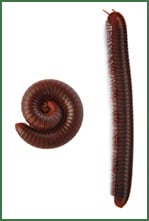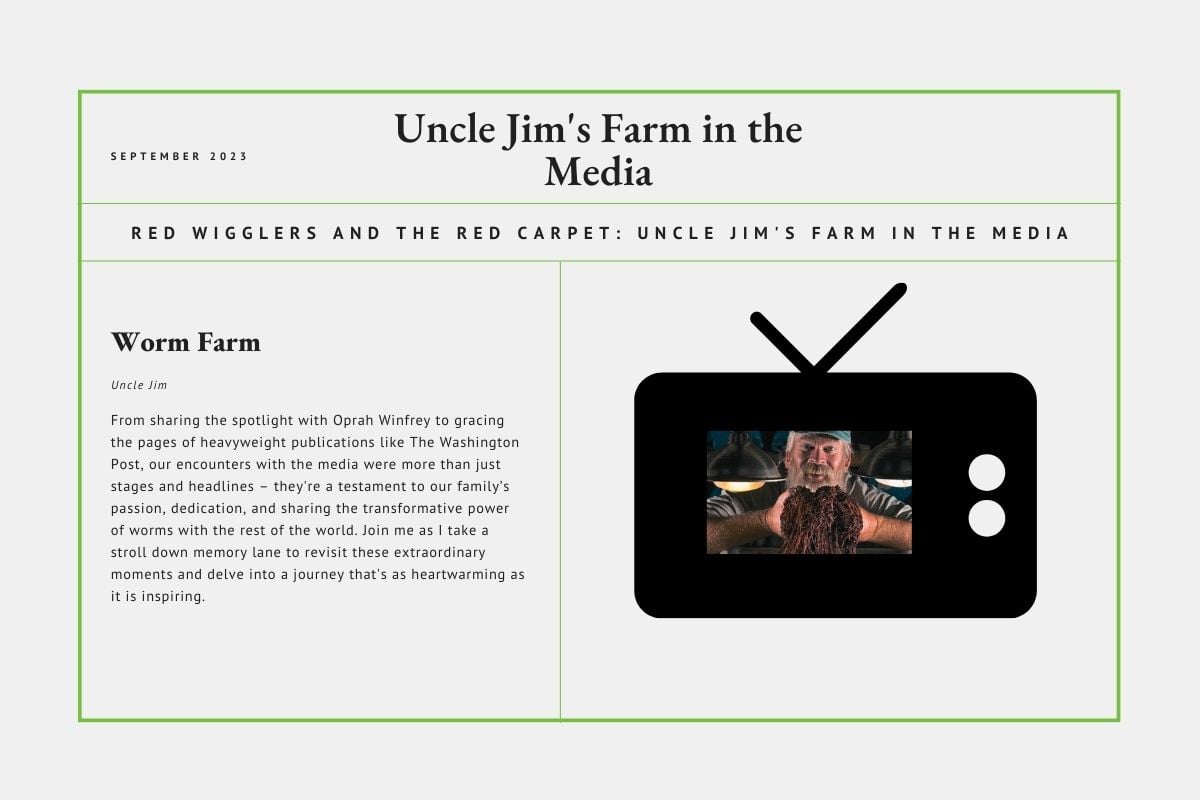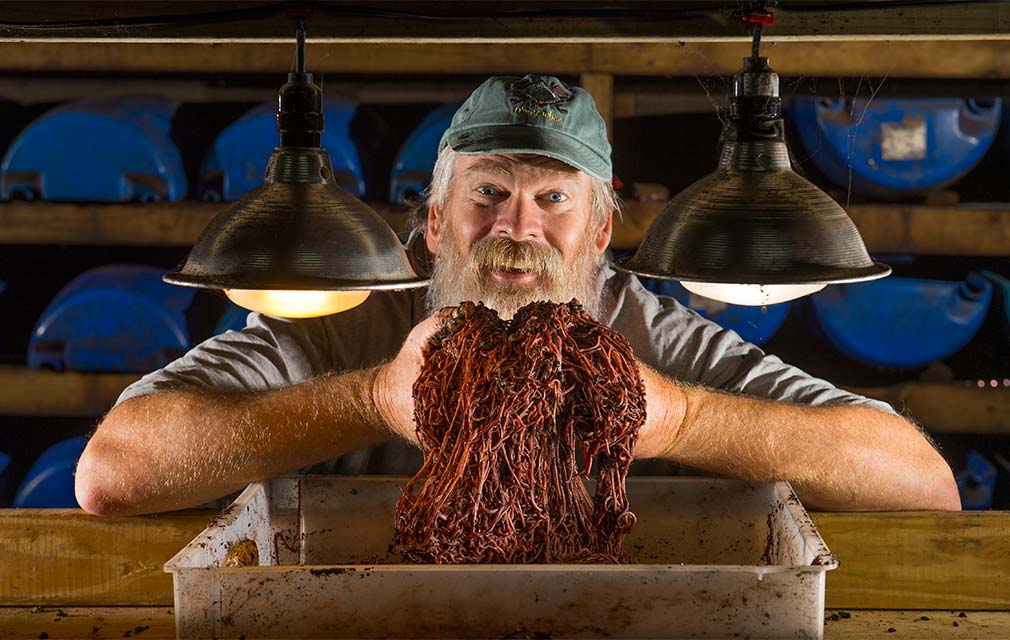From time to time, you might find some other critters vying for space with your worms in their bin. It’s important to identify and eliminate harmful pests before they can multiply or harm your worms. Below are some common critters you might find: millipedes, centipedes and mites. Find out what they’re doing in your bin, and ways you can best get rid of them.
Millipedes
Millipedes are big, rounded wormlike creatures with their defining set of hundreds of tiny legs (though their name means “1000 legs,” it’s usually more like 400). They are slow-moving creatures that usually live in soil or plant matter. Most range from a half inch to two inches long, and their main duty is eating dead and decaying plants.
Though millipedes look a little creepy, almost all species are actually beneficial to your garden and harmless to your worms! They are not true pests. You’ll usually find them in the bin if you’re using composted plant material or manure for bedding. They are only there to perform the same job as your worms by breaking down organic matter. There is no need to remove or kill them, but if you’d rather not have them there, it’s easy to pluck them out by hand without any harm to you or your worms.
Centipedes
Centipedes are recognizable by their long flat bodies with the telltale 100 legs. They usually live in soil or humus and under objects like logs, rocks, and bark. They range from one inch to one foot long and come in a variety of colors, but all are predators to other animals. They run fast and kill with a set of sharp, poisonous claws, so they are certainly no friend to your worms.
If you do find that a centipede has come into your worm bin, you’ll want to remove and kill it as soon as possible before they eat your worms. The good news is that centipedes are territorial, so you shouldn’t find many in one spot. Some worm farmers say that pouring a little soda water on the centipede will stun it temporarily, but there’s not much secret to catching them. They’re fast, and you just have to chase them down as best you can and kill them with a garden trowel. Don’t worry, their venom isn’t strong enough to be lethal to humans, but their bite can be very painful, so be careful.
Mites
Mites are teeny tiny, one-fifteenth of an inch critters with eight legs. They are found nearly everywhere in the world and eat different things, from plants to other mites and creatures, depending on the species.
Mites are inevitably present in all worm bins, but you probably won’t notice them until their population has become too large, which can be well into the millions. The red mite is parasitic on earthworms, but any type of mite in large quantity is detrimental: your worms will stop coming to the surface to feed if there are too many. In general, you want to make sure your bin is not too acidic and wet, which is what mites like. Don’t overfeed (and no acidic foods) or overwater, and keep drainage holes open.
To get rid of mites already present, try one of these methods: reduce food and water input until mites start to leave; place potato slices, melon rinds, or damp newspaper on the surface of the bedding, then remove when mites have collected there; or water your bin thoroughly until mites come to the surface, then remove mites by torching, shop vacuuming, or sprinkling sulfur on them. If all else fails, replace your worm bedding entirely.












37 thoughts on “Get rid of Millipedes, Centipedes, Mites in Worm Bin”
Uncle Jim,
Can you send me a close up photo of a red wriggler egg? I want to make sure I am saving the right eggs!
Thank you,
Betsy
Is it normal to have tiny, white, round bugs, and slightly bigger round brown bugs in the bin? They are all over the inside of the lids. I’m also starting to see round hard shell snails in various sizes (but all tiny) in the my bins. Do I have reason to be worried? Are they beneficial? Is it necessary to get rid of them, and if so, is there a preferred way to get rid of them? I just don’t know what’s normal or beneficial when it comes to insects in the bins. Thank you.
I have a bug that i think is a meal worm in my night crawlers.I use corn meal to feed my worms.whatever bug this is they are hundreds of them now. They are about 3/8 inches long.I dont know what i need to do.
Do a google search for “black soldier fly larvae” and see if that looks like what you’re finding. I had some invade my outdoor worm bin awhile back, I ended up having to pick out the red wigglers and start a new bin inside, the black soldier flies had taken over.
I have these centipede like creatures in my worm bin, but they are much smaller than an inch. Maybe s 1/4 inch. So fast, can’t catch them. but I notice my worms don’t wiggle as much as they used to. I also noticed that it looks like there are less of them. Could they be baby centipedes? And they’re eating my worms? What do I do?
I got some bugs in my cornmeal that came with my worms. Is it still good to feed it to the worms?
I have this problem too please help Me asap
I have these centipede like creatures in my worm bin, but they are much smaller than an inch. Maybe s 1/4 inch. So fast, can’t catch them. but I notice my worms don’t wiggle as much as they used to. I also noticed that it looks like there are less of them. Could they be baby centipedes? And they’re eating my worms? What do I do?
Reply
A lot of blogs talk about getting rid of centipedes that are already in the worm bin. I want to know how to prevent them from getting in, in the first place. Thanks.
I have the same issue, seems like my worm population is down too
I also be am seeing many of the tiny cenipedes too many to pick out. Due to their size I can’t tell if they are milipedes or cenepedes . Please show some replies or however you give suggestions. I’m afraid of waiting too long and losing my worms. Thanks
https://naturesfootprint.com/community/articles/bugs-creepy-crawlies-whats-in-my-worm-bin/
This is a great link for worm bin creepie crawlies.
A good link, thankyou.
We have been having the same centipede issue at my school. We have been hand picking them out of our bin to remove them from the worms. The students LOVE this activity! The centipedes are very crafty, and quickly go under the soil to hide. I would LOVE to know how to prevent them from finding the bin inside my classroom! Please assist if you can. Thank you
Hello..Are dogs and cats or rats a danger to vermiworms?thanks.
I do not think most dogs or cats would care about the worm bin. However, most all rodents love to eat worms.
I cannot torch and none of the other methods worked. What is the easiest way to replace the bedding without losing worms or bringing the mites with them?
I started my worm bin about two weeks ago and it’s going to good but everytime I go to the basement (where the worms are) I find a new kind of bug in there. I have the really little tiny ones that crawl all over the place I can’t tell what they are. Then I have the fruit flies that are so bad no matter what I do. And they are coming upstairs to the rest of the house my mom doesn’t know it’s from the worm bin I just act like I don’t know where they are coming I really don’t. Then now the little black centipede looking bugs. I don’t know what to do. The worms look alright but I can’t get a good look at then because I just get tons of bugs flying at my face. There’s not even a lot of food in there. Should it be dry or wet in there? I have so many questions..
Fruit flies can be controlled by using less food, burying the food in the bibs, and covering bins with a towel. You can also make a small dish of water apple cider vinegar sugar and dish soap to trap them. Theses traps can be laid inside the bin or outside. Good luck!
I had a centipede problem. Many were right under the boards I lay down over my worm area. I used pure distilled white vinegar, with a few drops of dawn dishwashing soap, and quickly lifted the cobpver and sprayed the buggers. This was two days ago and no centipedes yet. I raked back the surface to remove the surface, and the worms seem fine.
Jada – I can give suggestions for the fruit flies. Freeze your worm food (let thaw and come to room temp before feeding) because that kills any fruit fly eggs already laid. Make the worm food smaller so that they can eat it before the flies go crazy. Don’t store any worm food down there while you’re waiting to feed as the flies will be attracted to it. If you can, set up a small fan that blows over the top of the bin, that will make it harder for the flies to find the source of their food and enter the bin itself – just be careful about how that affects the moisture and temperature of the bin. And lastly, set up fruit fly traps to get rid of what is there. Good luck!
The really little tiny ones sound like mites. Try the suggestions proposed on this blog for mites.
Moisture – damp, rung out sponge. If you squeeze the bedding you shouldn’t see any drops of water come out. Make sure you have drainage and aeration holes.
What is the name of the very common, slow-moving, watermelon-rind-eating red mite that is in our bins? I’ve read article after article and not one has mentioned the name of the mite.
I have the same small centipede problem and the pest ID link doesn’t show anything similar to the small centipede
I lost 8,000 worms, all of them, to centipedes. The only solution I have found is throw out the dirt and start over. darn.
My worm bin is only four days old, I keep it in a temperature controlled basement and I have seen a few of the very small centipede- like bugs. Could they have arrived with my worms? I bought 6,000 worms and I feel like they are already at risk. Help!
I found a millepied in my bedroom?why??
Why was a millepied in my bedroom?
I really need help. I have a bin with a lot of worms. On the top layer, a lot of worm poop. In that poop, there are a lot of little bugs/aka. mites. It’s probably two inches deep of the poop, and millions of mites. I keep this in my basement.
What should I do?
Hi Michael,
I am sorry to hear this! The mites can seem overwhelming when they get very bad. To get rid of mites already present, try one of these methods: reduce food and water input until mites start to leave; place potato slices, melon rinds, or damp newspaper on the surface of the bedding, then remove when mites have collected there; or water your bin thoroughly until mites come to the surface, then remove mites by torching, shop vacuuming, or sprinkling sulfur on them. If all else fails, replace your worm bedding entirely.
Hi Michael,
Thanks for reaching out! If you are noticing that there is a lot of poop, I think it may be time to change out your bedding! The mites are very attracted to this sort of moisture. Once you change the bedding keep an eye on the moisture level. If there is still issues with the mite you can dry the bin out just enough where the mites won’t like it.
Have a great day,
Uncle Jim’s Worm Farm Team
I heard that white spring tail mites work in a symbiotic relationship with the worms and are actually a good thing to have in your bin cause using the combination of African nightcrawlers, red wigglers and white spring tails helps overall health of your garden and helps keep the bad bugs away. Is there any truth to this??
I’ve had thousands of millipedes. On my front walk,crawling up front of house etc. why do I have them and how can I get rid of them
The Ants have invaded my Meal Worm bin! Help.! I have balanced the bin on another, over a pan of water. As long as there’s water in the pan the ants are kept out. I’m looking for other ways to tell the ants, “Keep Out!” What has worked for you?
We have millipedes too…..can’t keep them out of our pool……they seem to gravitate to fresh water.
Do they also live in potted plants around the pool inside the cage?? Never see them on pots or plant leaves……just crawling on the floor…..or floating in the pool. Help!
I have a ton of tiny little white dots, very very tiny. only in soil and food. no flies. I’ve googled pics of everything mentioned above, can’t find the answer if they are harmful or not. any ideas?
Hello Michelle;
Thank you for your comment. Are these dots moving? They could be mites and they are quite common in worm bins. You can contact us at our Customer Service department and send a photo and we will help you figure it out if you wish.
Uncle Jim’s Worm Farm
Why are there no visible replies on this blog?
Anyway, the answer is to use diatomaceous strictly food grade to kill the bugs. The earth worms can use the diatomaceous earth for their bodily digestion and are unharmed by it. But all bugs will die if it gets on them.
Thank you to the person suggesting diatomaceous earth! I have the same issue as many people (the tiny 1/4 inch millipedes) and your answer is the only solution I can see working. You’re right there isn’t much help from admin.